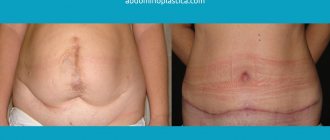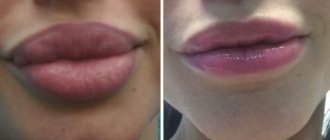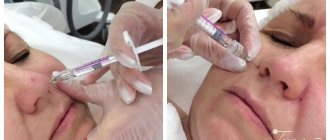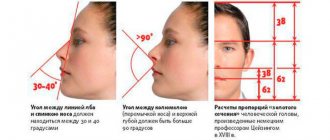- Preoperative period
- Preparing for surgery
- Choice of anesthesia
- Carrying out the operation
- Video of the operation
- Recovery period
- Contraindications
- Possible complications
Otoplasty is the surgical elimination of congenital or acquired (traumatic) ear defects. This operation is one of the most common in plastic surgery and allows you to adjust the size of the ears, their shape and location relative to the face. The surgical intervention affects the cartilaginous as well as soft tissues of the ears. Otoplasty is often recommended for children and adolescents, since protruding ears, asymmetry of the ears and other congenital defects can cause psychological disorders.
Preoperative period
In addition to choosing a clinic with an impeccable reputation and qualified staff, an important part of the preoperative period is a detailed consultation with the surgeon who will perform the intervention.
Modeling the shape of the ear
!Before otoplasty surgery, it is important that the patient and the doctor reach full understanding regarding the aspects of the proposed correction and its final result. The doctor explains to the patient how otoplasty is performed, how long the procedure itself and the rehabilitation period take, and what effect should be expected.
Modern high-level clinics have the ability to simulate the result of an operation on a computer in a digital 3D format. However, the client needs to understand that otoplasty surgery, like any other plastic surgery operation, is associated with certain risks. Realistic expectations about the final result include the possibility of insufficient correction or the development of some complications.
Preparing for surgery
Before undergoing plastic surgery, you must undergo a full medical examination. Direct preparation includes consultation with a therapist; if the patient has chronic diseases, a conversation with relevant specialists is also necessary. In addition, it is necessary to undergo a laboratory examination, as well as fluorography and electrocardiography.
Mandatory tests for otoplasty include:
- General blood analysis;
- Analysis of urine;
- Biochemical blood test (glucose, protein, electrolytes, urea, bilirubin);
- Testing for antigens and antibodies (tests for hepatitis and HIV);
- Test for syphilis.
Doctors need to find out whether the patient is prone to allergic reactions or the formation of keloid scars, and what operations they have undergone previously.
Before otoplasty it is necessary to undergo fluorography
Several weeks before the scheduled day of surgery, it is advisable to prepare the body. It is useful to take vitamins and follow a diet with sufficient amounts of protein, fruits and vegetables. Two weeks before surgery, the patient must stop taking medications that affect blood clotting. Smokers are advised to give up cigarettes at least temporarily. Moderation in alcohol consumption before and after surgery is also recommended.
On the appointed day, 4 hours before the procedure, it is advisable to refrain from drinking and eating. The day before surgery, you should thoroughly wash your hair and ears.
Before otoplasty, the surgeon also takes general and detailed photographs of the auricles, takes all necessary measurements of each ear, determines the relationship of the ears to the border of the scalp, takes into account the presence of asymmetry and the relative position of the concha, lobe, and helix.
Can ears protrude again after otoplasty?
“I always like to say that surgery is a little more accurate than religion. It is impossible to predict 100% that everything will be the way we want. It often happens that nature intervenes in the process and one ear may, over time, protrude a little more than the other. Therefore, it happens that we make a slight correction,” summarizes Yuri Mirzabekyan.
An experienced doctor resorts to slight hypercorrection, with the aim that the ear will “move away” a little during the recovery period, already in the process of otoplasty. In this case, you shouldn’t squeeze too much, because some patients, for example, wear glasses. And a tightly pressed ear does not look very aesthetically pleasing.
To see the final result of the operation, you need to wait until the swelling goes away completely. Therefore, a full photo from the “Otoplasty: before and after” series can be taken only after a few months. Sometimes it may seem to the patient that the ear is not positioned correctly, but in fact the reason for this may be uneven convergence of the swelling. In such cases, surgeons recommend not to panic, because even if correction is necessary, it will be minimal.
Choice of anesthesia
The choice of type of anesthesia for otoplasty depends on many factors:
- Patient's age;
- Difficulties of the operation;
- Estimated duration of the surgical procedure;
- Presence of concomitant diseases;
- Psychological state of the patient.
In children and adolescents, the intervention is performed under general anesthesia (drugs are administered intravenously). In healthy adult patients, surgery is often performed under local anesthesia. Sometimes sedative and analgesic medications are administered intravenously.
Carrying out the operation
Otoplasty cannot be classified as a difficult operation for a qualified specialist: it is performed on an outpatient basis (the patient does not need to be hospitalized).
Prominent ears can be corrected with otoplasty
If correction of protruding ears in children is carried out, then the ideal time for otoplasty is 5-8 years. By this time, the child has not yet had time to form a critical attitude towards his appearance, and in the future, young patients simply forget that they were once “lop-eared.”
Otoplasty options depend on the anatomical features and the technique chosen by the surgeon based on his professional experience. ! Modern aesthetic surgery includes more than 150 methods for correcting protruding ears and other ear defects. The general goal of protruding ear surgery is to bring the ears closer to the head: this is achieved by plastic surgery of the cartilage that forms the basis of the outer ear.
For these purposes, an area of skin behind the ear is excised, and the cartilage is partially removed (or it is shaped in such a way as to give the shell the most aesthetic appearance). This way, the incisions and future scars remain on the back of the ear, making them invisible. Over time, the scars become completely invisible.
Bandage after otoplasty surgery
The ideal angle between the concha of the ear and the head is 30°, while the distance between the head and the edge of the ear should not exceed 2 cm. The deformation can be observed in both ears or one, and the types and degrees of protruding ears and other ear defects are so diverse that there is no single medical tactic there is simply no fix.
! The duration of the operation depends, of course, on its complexity and course. Usually the procedure takes from half an hour to 2 hours. The patient remains in the clinic for several hours (sometimes until the next morning). The next day he can do his normal activities. Children can start school in a week.
Immediately after the treatment, medical napkins and a special bandage after otoplasty are applied to the correction areas. A special tampon soaked in plant oils and antiseptic components is inserted into the ear canal. The tampon should be changed every three days. A day after surgery, the first dressing is performed. A photo of the postoperative period of otoplasty clearly demonstrates the condition of the patient’s ears after the procedure.
Types of otoplasty
- aesthetic (when the shape of the ears changes or they are given a more aesthetically correct appearance);
- reconstructive (restoration of a completely or partially absent auricle, both after congenital pathology and after injury);
- decorative otoplasty (a type of body modification, a newfangled trend in which “elven” ears with pointed ends are created).
Regarding decorative otoplasty, most plastic surgeons speak very coolly: from an aesthetic point of view, such an operation is not justified. Nevertheless, this operation has fans, and a number of clinics perform them. Doctors immediately warn those who want to have pointed ears: think about this in a calm mood, because you will get elven ears forever. This is a full-fledged surgical intervention - with anesthesia, a postoperative period, and you will have to take care of the stitches and give up your usual lifestyle for a while. Besides, if you suddenly want to return your ears to their previous shape, it will be impossible.
Reconstructive surgery of the outer ear corrects such defects as the already mentioned anotia - complete or partial absence of the ear due to injury or prenatal causes, various rudiments of the ear. This type of surgery often uses “donor” sites from other parts of the body, such as rib cartilage or cartilage from another ear. In our country, reconstructive operations have become widely developed and widespread. The main reason is that powerful military operations took place in our country, and people returning from the front often had combat injuries that also affected their ears.
There are more than 170 methods by which this deficiency can be corrected, and each doctor chooses a specific one for himself or practices using a complex of elements from different methods. It happens, for example, that the severity of protruding ears differs on the right and left, so the elements of the operation used to correct one ear and the other may also differ.
The traditional method of performing the operation involves the use of a scalpel. There is also laser otoplasty, in which incisions are made with a special laser. This process occurs much faster, and in addition, the likelihood of complications is reduced.
Note: plastic surgeons are most often approached by people who want to correct protruding ears - unilateral or bilateral. The cause of protruding ears is underdevelopment of the antihelix of the ear, as well as an increased angle between the ear and head.
Many patients have their own vision of the ideal ear shape. Yuri Mirzabekyan gives an example when a person consulted doctors twice:
“Previously, this patient had bilateral protruding ears, he was operated on and the result of eliminating the protruding ears was quite satisfactory to him. However, he did not like the size of his ears: he had so-called macrotia, large ears. I can’t say that the size of his ears went far beyond aesthetic standards or anthropometric data. But we met the patient halfway - we reduced his ears, and he was satisfied.”
Note: the shape and size of the auricles with protruding ears are within normal limits, only the auricles are located not exactly parallel to the temporal region, but more at a right angle. The ideal angle between the auricle and the head is 30 degrees.
Recovery period
Immediately after surgery, the doctor prescribes painkillers (analgesics), which should be taken again after 2-3 hours and before bedtime. Pain after otoplasty usually does not last longer than a day or may be quite mild for several days. To eliminate pain symptoms, pharmaceutical analgesic drugs are quite suitable. Hematomas can be severe for a week, after which they gradually disappear. Swelling after otoplasty persists for 1.5 months.
Suture line after otoplasty
For a week, you should definitely wear a bandage made of several layers, which fixes the ears in a certain position and provides protection from mechanical stress (see photo of the bandage after otoplasty). Patients should also protect their ears from water getting into them. Sutures after otoplasty are removed after about 7 days.
! Complete rehabilitation after otoplasty lasts approximately six months. For 5-8 weeks, the patient is recommended to sleep in a special fixing bandage that prevents the displacement of cartilage. The bandage is put on after the stitches are removed. You should also protect your ears after otoplasty from insolation (solar radiation) and exposure to cold wind.
You can wash your hair 2 weeks after surgery. You can't go to the sauna or swimming pool for a month and a half. After 3 and 6 months, the patient should visit the surgeon for examination and consultation regarding the course of the recovery period.
During the rehabilitation period after otoplasty, patients are not recommended to engage in contact sports, diving, or weightlifting, since there is a high probability of injury and deformation of the operated cartilage.
Reviews from patients after otoplasty surgery are mostly positive - after recovery, people quickly get used to their new appearance and get rid of all complexes and psychological problems associated with ear defects, if any.
Possible complications
Otoplasty, rehabilitation after which requires a serious approach, can also cause complications. Negative consequences are rare and almost always occur as a result of patients’ non-compliance with medical recommendations. Complications after otoplasty due to medical error are also possible.
Ear swelling is one of the complications
Complications after ear correction include:
- The occurrence of allergies (epidermal blisters) - this may be a reaction to anesthetics and other medications;
- Complications due to anesthesia (more often occur in children);
- Inflammation of soft tissues (prolonged swelling and redness of the ears);
- Inflammation of cartilage tissue (perichondritis);
- Formation of keloid scars;
- Deterioration of the aesthetic result due to spontaneous deformation of the ears.
Some of these complications can be prevented if you strictly follow your doctor's instructions. If negative reactions develop, repeated correction of the ears may be required, which can be carried out no earlier than 6 months after the first procedure.
If the patient follows all the recommendations for the rehabilitation period after otoplasty, no re-correction will be required. The result will be sustainable and will remain with the person for life.
Indications and contraindications for otoplasty
Indications for otoplasty:
- protruding ears;
- macrotia and microtia ;
- irregular shape or disproportion of the ears (flattened ears, pointed ears);
- ingrown ears, thick ears;
- restoration of the auricle or torn lobe.
It is best to perform the operation in childhood, up to 6 years, when ear growth is complete, before starting school life in order to avoid possible ridicule from classmates.
However, there are contraindications to otoplasty. The main contraindications to otoplasty:
- decompensated diabetes mellitus ;
- bleeding disorders;
- diseases of internal organs, including chronic infectious diseases;
- some mental and neurotic disorders .
Indications for otoplasty for protruding ears are the most common. Treatment with surgical methods was carried out as early as the 1840s.
The main goal of otoplasty is to correct the protrusion of the upper part of the ear. The main methods of plastic surgery of the auricles are to reduce its size, remove the skin behind the ear ( Mustarde method ), as well as weakening the antihelix cartilage and giving it a shape in the folds.











